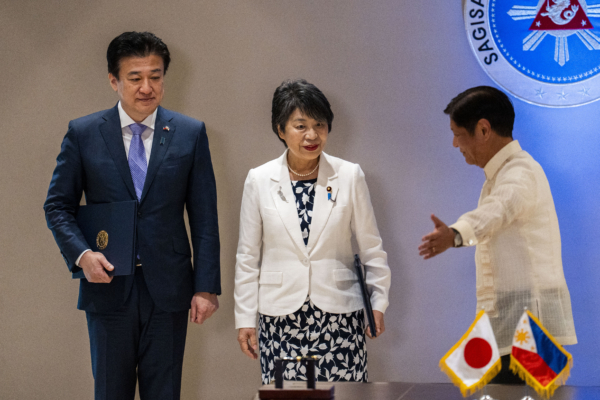On July 8, 2024, amidst the increasing threat of regional expansionism from the Chinese Communist Party, the Philippines and Japan signed a landmark military agreement that allows both countries to deploy forces on each other’s territory. The Philippines praised the unprecedented level of defense cooperation reached between the two nations.
The Philippine Secretary of National Defense, Gilberto Teodoro, and the Japanese Foreign Minister Yoiko Uekawa signed the Reciprocal Access Agreement (RAA) in Manila under the witness of Philippine President Ferdinand Marcos Jr. This agreement permits military forces from both the Philippines and Japan to conduct joint training exercises on each other’s soil.
The RAA marks the first of its kind agreement signed by Japan in Asia which will facilitate the entry of Japanese equipment and troops into Manila for operational training and disaster relief, thereby enhancing military cooperation between the Philippines and Japan.
Following the “2+2” meeting between the foreign and defense ministers of both countries, Philippine Foreign Minister Enrique Manalo stated during a joint press conference that the RAA elevates their defense partnership to unprecedented heights.
Uekawa described the signing as a “groundbreaking achievement” that will further promote defense cooperation between the two countries.
Against the backdrop of increasing tensions between the Philippines and Beijing in the South China Sea, where the Philippines has faced continued obstruction from China in supplying its troops stationed at the disputed Second Thomas Shoal, the signing of this agreement takes on added significance.
Last month, a Philippine sailor was injured in a clash with Chinese forces while carrying out this mission. Both Japanese and Philippine officials expressed serious concern over China’s actions in the Second Thomas Shoal.
The international community has been urged in a joint statement to uphold and strengthen the rule-based, free, and open international order, with China’s actions in the disputed waters obstructing freedom of navigation, disrupting supply lines, and exacerbating tensions.
China has accused the Philippines of instigating violence and claimed that the Philippine sailor disregarded warnings and entered what China calls its territorial waters.
Japan and the United States have both denounced China’s actions and called on the Chinese government to abide by international law.
The defense agreement signed between Japan and the Philippines includes live-fire exercises, marking Japan’s first defense pact signed in Asia. The treaty will come into effect after approval by both countries’ parliaments.
The Philippines and Japan, both close allies of the United States in Asia, have taken a firm stance against China’s increasing encroachment in the South China Sea and expressed concerns over the tensions in the Taiwan Strait.
China claims sovereignty over nearly the entire South China Sea, a vital trade route for Northeast Asia and other regions, with Brunei, Malaysia, the Philippines, Taiwan, and Vietnam also asserting territorial claims in the region.
In 2016, the International Tribunal in The Hague ruled that China’s extensive sovereignty claims in the South China Sea held no legal basis, a decision rejected by the Chinese government.
Faced with China’s growing assertiveness, President Marcos Jr. has sought to establish a security alliance with Western allies led by the United States to enhance the Philippines’ military capabilities in defending its sovereignty interests in the South China Sea.
While Japan does not have territorial claims in the South China Sea, it has long-standing territorial disputes with China in the East China Sea. Under Prime Minister Fumio Kishida’s leadership, Japan has taken steps to bolster its security and defense capabilities, including its counterattack capabilities, breaking away from its post-war defense-focused principles.
Japan plans to double its defense spending within five years by 2027 to strengthen its military power. Japan and the Philippines have been steadily deepening their defense and security ties.
As the location with the highest concentration of U.S. overseas forces, Japan has signed Visiting Forces Agreements with Australia and the UK in 2022 and 2023, respectively, and is in negotiations with France for another agreement.
The Philippines has also signed Visiting Forces Agreements with the U.S. and Australia.
The U.S. has been enhancing its military alliances in the Indo-Pacific region to better counter China, including reassuring its Asian allies in any future Taiwan-related confrontations.
During the same press conference, Japanese Foreign Minister Yoiko Uekawa reiterated the importance of peace and stability in the Indo-Pacific region and warned against unilateral attempts to alter the status quo through force and coercion.
In Beijing, a Chinese Foreign Ministry spokesperson referred to the Asia-Pacific as a “small circle” fueling a new Cold War.
Japan and the Philippines, both treaty allies of the United States, held a trilateral meeting at the White House in April, where President Joe Biden reaffirmed the U.S.’s “unwavering” commitment to defending Japan and the Philippines.
According to the 1951 U.S.-Philippines Mutual Defense Treaty, the United States is obligated to defend the Philippines if its military forces, ships, or aircraft are attacked, including in the South China Sea.

